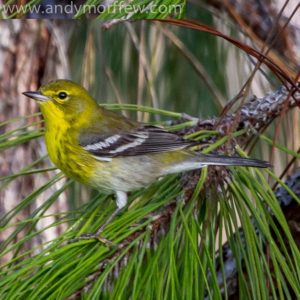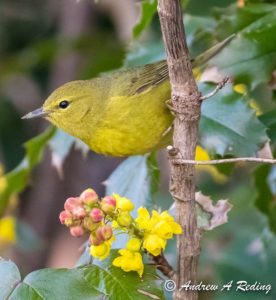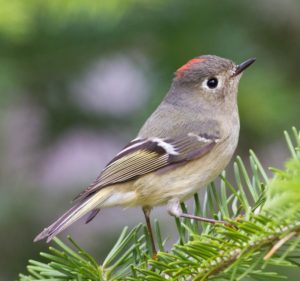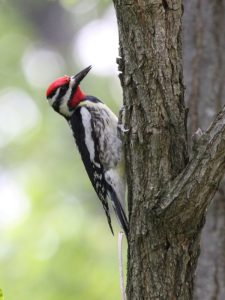Wildlife Wednesday: Winter Birds at Russ Pitman Park
We have finally entered our winter bird season here on the Gulf Coast of Texas, and here at the Nature Discovery Center (in Russ Pitman Park). Most of our Fall migrants have flown through and moved on to South Texas, Mexico, and Central America, and many of the birds that spend the winter in our area have begun to arrive. On today’s Winter Bird Walk, and in previous days, we’ve seen some of these much anticipated birds feeding and singing in the park, many right out in the front yard area. Today, we take a look at a few of these recently seen wintering bird species.
 Pine Warblers (Dendroica pinus) breed in the Eastern United States from East Texas to New England, but we don’t really have them here in the Houston area until winter. As the name would suggest, the bird is heavily associated with Pine Trees, where they nest and search for food under pine bark and in pine cones. They have a varied diet of seeds, berries, and insects. As with most new world wood warblers, the males are more vibrantly colored than the females.
Pine Warblers (Dendroica pinus) breed in the Eastern United States from East Texas to New England, but we don’t really have them here in the Houston area until winter. As the name would suggest, the bird is heavily associated with Pine Trees, where they nest and search for food under pine bark and in pine cones. They have a varied diet of seeds, berries, and insects. As with most new world wood warblers, the males are more vibrantly colored than the females.
Orange-crowned Warblers (Oerothlypis celata) are another winter warbler for the Houston area. They nest and raise young in the Western U.S., Canada, and Alaska. The yellowish males are fairly dull colored for wood warblers, and the females are even drabber in coloration. The western populations are somewhat less colorful even than the more yellowy Eastern populations. The male does occasionally show off a small dark orange patch on the top of the head, when excited, but the orange crown is usually unseen. Orange-crowned Warblers feed on berries, insects, and flower nectar. We sometimes see them feeding at hummingbird feeders in the park during the winter.
 We also find Ruby-crowned Kinglets (Regulus calendula) feeding on sugar water from hummingbird feeders in our park during the winter. The small gray birds are easily recognized with their black and white wing bars, but the small ruby colored crest on the top of the head is not always easy to spot. When the birds are active and excited they may raise it up for you. They are bold little birds, often approaching birdwatchers out of curiosity or to scold them away. They’re common here in the winter, but during the breeding season, they completely disappear from this part of the country, as they breed in the Rocky Mountain corridor of the Western United States, through much of Canada, and Alaska. They feed on flower nectar, insects, tree sap, and berries.
We also find Ruby-crowned Kinglets (Regulus calendula) feeding on sugar water from hummingbird feeders in our park during the winter. The small gray birds are easily recognized with their black and white wing bars, but the small ruby colored crest on the top of the head is not always easy to spot. When the birds are active and excited they may raise it up for you. They are bold little birds, often approaching birdwatchers out of curiosity or to scold them away. They’re common here in the winter, but during the breeding season, they completely disappear from this part of the country, as they breed in the Rocky Mountain corridor of the Western United States, through much of Canada, and Alaska. They feed on flower nectar, insects, tree sap, and berries.
One of our favorite winter woodpeckers is the Yellow-bellied Sapsucker (Sphyrapicus varius), which feeds on tree sap by making holes or sap wells in a variety of trees. They maintain these patches of sap wells, pecking at them occasionally to keep them running, and defending them from other birds. The males are more colorfully marked than the females, and they can be somewhat territorial, even in winter. These lovely woodpeckers also feed on the insects that come to consume the sap from the wells. Sapsuckers know to make different shaped sap wells for different species of tree, as various saps have different viscosities and flow rates.
So, those are a few of the winter birds we’ve seen more recently at the Nature Center as of late, and hopefully, you can come out to the park soon and see some of them for yourself. Remember, its not just parks that have wintering birds, you probably have them visiting your yard, as well. Birdfeeders and bird baths are a great way to invite them them close to your home.
Our next two guided Winter Bird Walks are January 10th & February 7th, from noon to 1:30 PM. (Find out more here.)
Thanks for joining us this week. See you soon!
Eric Duran
Staff Naturalist
photos: Top – Eastern Bluebird and Pine Warbler by John Flannery | Flickr; Pine Warbler – Andy Morffew | Flickr; Orange crowned Warbler – Andrew Reding | Flickr; Ruby crowned Kinglet – Fyn Kind | Flickr; Yellow bellied Sapsucker – Dominic Sherony | Wikimedia



